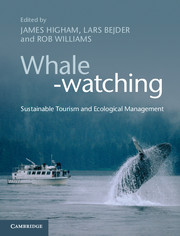Book contents
- Frontmatter
- Dedication
- Contents
- Acknowledgements
- List of contributors
- List of abbreviations
- 1 Tourism, cetaceans and sustainable development
- Part I The historical and contemporary contexts
- Part II Human dimensions of whale-watching
- Part III Ecological dimensions of whale-watching
- Part IV Sustainable management: insights and issues
- 18 The socioeconomic, educational and legal aspects of whale-watching
- 19 Vigilance, resilience and failures of science and management
- 20 Insights from agent-based modelling to simulate whale-watching tours
- 21 Cetacean-watching in developing countries
- 22 Kaikoura (New Zealand)
- 23 Management of dusky dolphin tourism at bKaikoura, New Zealand
- 24 Save the whales Part II
- 25 Time to rethink
- Index
- Plate Section
- References
24 - Save the whales Part II
A new science advocacy communication framework
from Part IV - Sustainable management: insights and issues
Published online by Cambridge University Press: 05 April 2014
- Frontmatter
- Dedication
- Contents
- Acknowledgements
- List of contributors
- List of abbreviations
- 1 Tourism, cetaceans and sustainable development
- Part I The historical and contemporary contexts
- Part II Human dimensions of whale-watching
- Part III Ecological dimensions of whale-watching
- Part IV Sustainable management: insights and issues
- 18 The socioeconomic, educational and legal aspects of whale-watching
- 19 Vigilance, resilience and failures of science and management
- 20 Insights from agent-based modelling to simulate whale-watching tours
- 21 Cetacean-watching in developing countries
- 22 Kaikoura (New Zealand)
- 23 Management of dusky dolphin tourism at bKaikoura, New Zealand
- 24 Save the whales Part II
- 25 Time to rethink
- Index
- Plate Section
- References
Summary
If a solution is to speak to a people and not end up as the private answer of a sect, it needs to find roots in their life, language and thought
(Campbell, 1974: 444)Introduction
The context for this chapter is the uncontrolled explosive growth of global whale-watching and the failure of widespread sustainable practices. Economic imperatives and environmental marketing have driven the global growth of whale-watching (Neves, 2010). In this chapter I argue that the widespread failure of sustainability is, in part, due to ineffective public communication and poor uptake of science related to impact assessments of whale-watching. The production and traditional scientific dissemination of research alone, while influencing the discourse and development of whale-watching in some contexts, have not been enough to contribute to the long-overdue evolution towards sustainable whale-watching. This chapter calls for the need to raise and address a range of new questions relating to the efficacy of science and the urgent need to improve science communication. New questions need to be asked to address the failure of collaboration between whale-watch stakeholders in order to catch up with the realities of global unsustainable whale-watching practices (Corkeron, 2004; Neves-Graca, 2004; Higham & Bejder, 2008). The current work proposes a new science advocacy communication framework for the whale-watching setting drawing on elements of science communication, media studies, marketing and tourism management. This audiovisual Science Communication Commercial, or SciCommercial for short, presents a potential management tool for the whale-watching industry by advocating sustainable practices to stakeholders, increasing awareness about impacts and managing visitors' expectations.
- Type
- Chapter
- Information
- Whale-watchingSustainable Tourism and Ecological Management, pp. 352 - 364Publisher: Cambridge University PressPrint publication year: 2014
References
- 3
- Cited by



